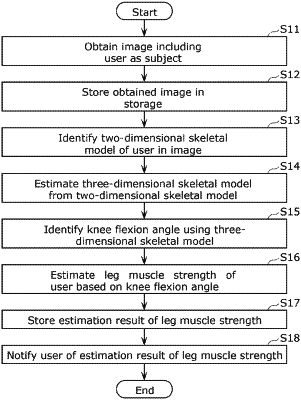| CPC G06T 7/0012 (2013.01) [G06V 40/25 (2022.01); G06T 2207/10016 (2013.01); G06T 2207/20081 (2013.01); G06T 2207/30004 (2013.01)] | 10 Claims |

|
1. A leg muscle strength estimation system, comprising:
a camera that obtains an image including a user that is walking as a subject of the image; and
a processor and a memory storing a program, wherein:
the program, when executed by the processor, causes the processor to:
identify a two-dimensional skeletal model of the user based on the image obtained;
use a machine learning model to estimate a three-dimensional skeletal model of the user based on the two-dimensional skeletal model identified;
obtain a knee flexion angle of the user while the user is walking based on the three-dimensional skeletal model estimated; and
estimate a leg muscle strength of the user based on the knee flexion angle of the user, and
the smaller the knee flexion angle of the user while the user is walking is, the greater the leg muscle strength of the user is estimated to be.
|